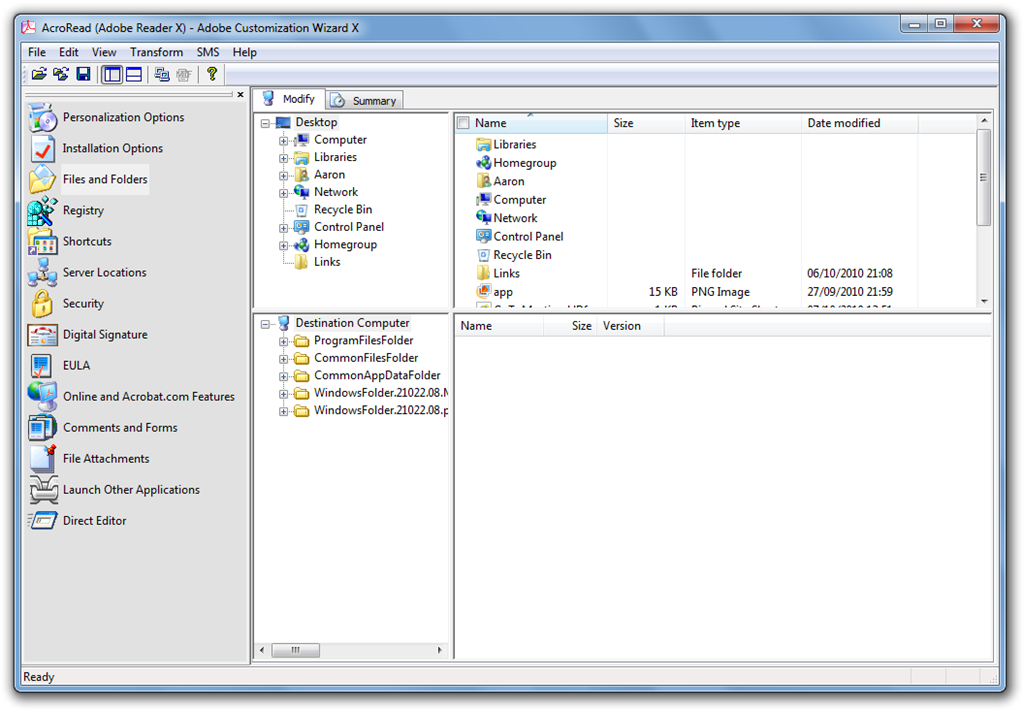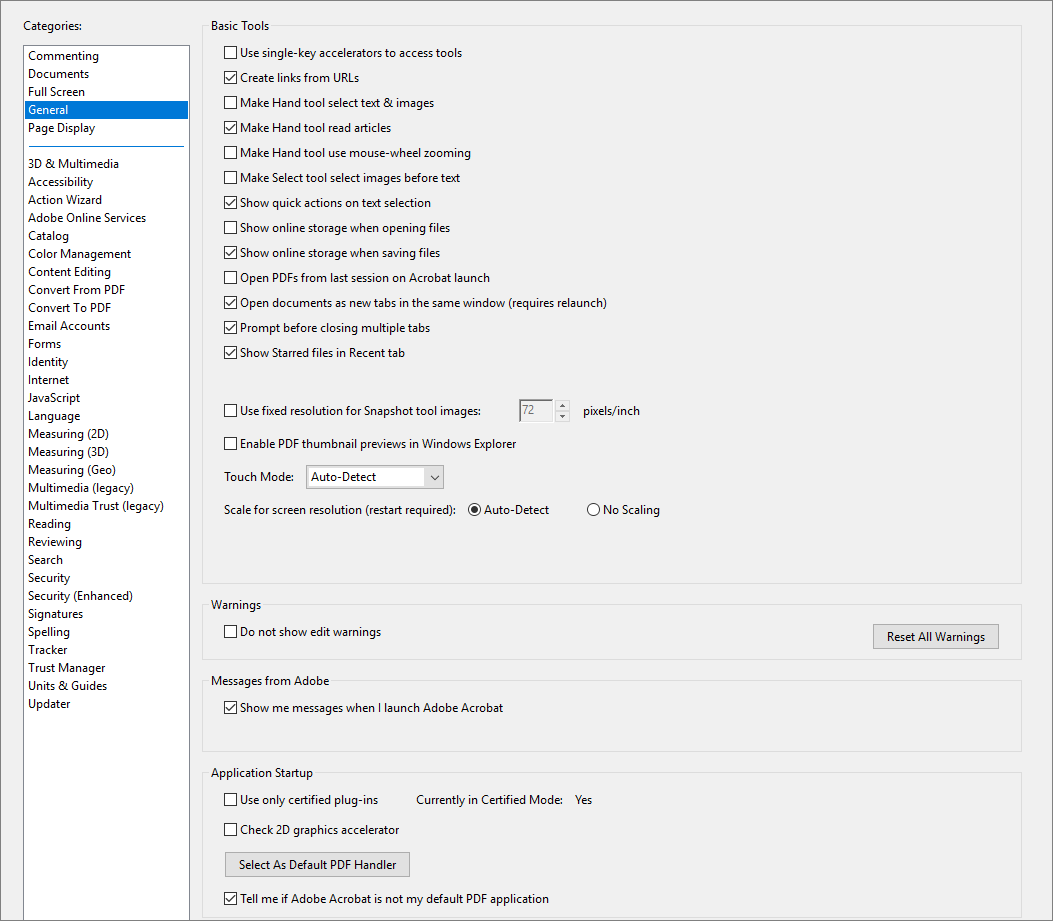- Scripting Languages
- Batch Files
- C#
- Development Software
- KiXtart
- Perl
- PowerShell
- Regular Expressions
- Rexx
- VBScript & WSH
- Technologies
- WMI
- ADSI
- Silent Installs
- Scripting Tools
- Miscellaneous
- Hardware
- About This Site
- At a high level, the steps include: Do one of the following: Create a Group Policy which runs a file copy script at system log on or log off or at a scheduled time. Place the files on the target machines via User Configuration Preferences Windows Settings Files or User Configuration Preferences Windows Settings Folder.
- AcroRd32.exe /t path 'printername' 'drivername' 'portname' Initiates Adobe Reader and prints a file, whose path must be fully specified, while suppressing the Print dialog box. The four parameters of the /t option evaluate to path, printername, drivername, and portname (all strings). Printername — The name of your printer.
- Choose the Program Type as Standard program. Deploying Adobe Reader Updates Using SCCM. Syntax – “ msiexec /update msipatchname.msp /qn (OR) msiexec /p msipatchname.msp /qn. Specify the name for the program, enter the command line msiexec /p AdbeRdrUpd110006.msp /qn and click Next. We now see that the Adobe Patch package is created.
Using Custom Commands. Let’s add the custom command to our Acrobat toolbar. To do that, we right-click on the gray background of the toolbar. This brings up a menu that allows us to select the “Customize Quick Tools” function: After we select “Customize Quick Tools”, we can then add commands to the Quick Tools area on the toolbar.
for specific software
On this page you'll find a (limited) collection of real life sample scripts and unattended installation procedures.
- Adobe Flash Player
- Adobe Reader 9 and 10
- install
- FireFox 3.* (and Thunderbird and Lightning)
- Foxit Reader 4.3
- Java Runtime (web package)
- OpenOffice.org
- Windows Genuine Advantage (WGA) Notifier for Windows XP
- Uninstall is not supported
- WordPerfect Office 12 ServicePacks
- .MSI packages
Adobe Flash Player
Install:
Obtain a free license to redistribute the software on your local network.
Download the Flash Player(s) for your browser(s), the URL will be sent by e-mail.
Install the downloaded .MSI file like any other .MSI:
| Note: | Many people, including myself, had trouble downloading the most recent Flash player for Internet Explorer from Adobe's Flash download page. In that case, try the download link for the executable installer on Adobe's Troubleshoot Adobe Flash Player installation for Windows page. |
Uninstall:
Before installing the new Flash Player, first remove the old one(s), before they become a security risk.
Download uninstall_flash_player.exe and issue the following command:
To uninstall just one (recent) version, you can also use the general MSI uninstall procedure.
Adobe Reader 9 and 10
Install:
Preferred method:

First complete the Adobe Reader Distribution Agreement which allows you to redistribute the software on your local network.
Next, download the redistributable version of Adobe Reader. The URL will be sent with the license.
Then use the Adobe Customization Wizard (link will be provided with the license) to create a customized MST file.
Finally, install Adobe Reader using SETUP.EXE, without any command line switches. The customizations are stored in the .MST file, and the .INI file will tell setup to use that .MST file.
Alternative method:
Download the appropriate Adobe Reader MSI.
If you prefer a non-English version, browse Adobe's public FTP site for the latest version in the language of choice.
Then install it like any MSI package.
Silent installation command for Adobe Reader 10.0.0 US (without 3D or multimedia plugins, no launch of the application after installation, no license popup, and no reboot):
A detailed description of command line options is available (of course) in PDF format. Though written for version 9's setup executable, it also lists MSI properties.
If you installed the Microsoft Windows SDK for Windows 7 then you can use the SDK's WiExport.vbs sample script (located in C:Program FilesMicrosoft SDKsWindowsv7.1Samplessysmgmtmsiscripts) to find available 'conditions' like DISABLE_3D=YES:
This command will create a file d:exportpathCondition.idt that contains a list of additional MSI command line arguments:
Likewise, some of the properties found in the Property table may be useful (not tested!):
This command will create a file d:exportpathProperty.idt that contains a list of properties, some of which may be used on the command line (not tested!).
FireFox 3.*
Install:
Download the latest FireFox 3.* version (e.g. 'Firefox Setup 3.6.12.exe').
Silently perform a default installation:
To change the installation options, you need to create/modify a configuration INI file and supply the full path to that INI file on the command line:
An example of what your INI file might look like:
Adobe Reader Supply Command Line Options Free
A detailed description of the options can be found at wiki.mozilla.org
You'll also find details on silent installation of FireFox version 4.* there.
| Note: | Rumor has it that Thinderbird installs likewise. To install Lightning after installing Thunderbird, download lightning-1.0b2-tb-win.xpi (or a later version) and run: FOR /F 'tokens=2*' %%A IN ('REG Query 'HKLMSOFTWAREMozillaMozilla Thunderbird' /v Currentversion') DO (The first part of this code reads the program directory from the registry. It can be replaced by a hardcoded path if you use a predefined installation directory. |
Uninstall:
Using CSCRIPT.EXE GetUnins.vbs /F:Firefox or GetUninstall.bat Firefox I found the following uninstall command:
helper.exe is located in a subfolder 'uninstall' of the FireFox program directory.
| Note: | The GetUnins* scripts may also help you find some plugins that you don't want to leave on the computer when uninstalling FireFox. |
Foxit Reader 4.3
Install:
Download Foxit Reader 4.3 (FoxitReader43_enu_Setup.exe).
To install Foxit Reader as default PDF reader for all users, with a Start Menu shortcut, without the browser plugin and without any 'piggyback installs':
| Notes: | More information on available command line switches for Foxit Reader 4.2/4.3 setup can be found here or using the command FoxitReader43_enu_Setup.exe /? |
The /allow and /disallow switches are mutually exclusive. | |
Using the /allow switch seems to always install the eBay shortcuts, even when not specified. |
Uninstall:
Using CSCRIPT.EXE GetUnins.vbs /F:Foxit or GetUninstall.bat Foxit I found the following uninstall command:
Uninstall.exe is located in the Foxit Reader program directory.
If you installed the plugin, you'll also find UnInstallPDFReaderPlugin.exe there.
Running UnInstallPDFReaderPlugin.exe does not uninstall the plugin, however, so to remove the plugin you need to perform a full uninstall and then reinstall Firefox Reader without the plugin.
| Note: | This information is outdated. Read more on deployment of Foxit Reader for its current Enterprise version. |
Java Runtime (web package)
Install:
Unattended or silent Java installations may seem confusing, as the documented command line switches simply don't seem to work.
Combined with the info I found at unattended.sourceforge.net however, I finally managed to install Java silently with the following command line:
Note that some of the command line switches are case sensitive.
Read the information at unattended.sourceforge.net for more details on the first couple of switches, as well as the information at java.sun.com for more details on the Java specific switches (the ones in capitals in the quoted part of the command line).
| Update: | For some Java versions you may have to remove the /s /a /s /sms command line arguments.Just try the commands on the command line. If any of the arguments is invalid you'll get an error message telling you which one. If you had to remove /s /a /s /sms then you are dealing with a packaged .MSI and only the /qn /norestart... switches are required, without the quotes and without the /v switch.The same is often true if the Windows Installer help pops up (or you made a typo in the .MSI switches): |
OpenOffice.org
Install:
First download the appropriate language version.
Move the downloaded executable to an empty directory and unpack it.
Unfortunately, unless you opt for SendKeys, there is no 'unattended' command to unpack.
You can specify the directory where the unpacked files should be sent to, by using the /D switch (case sensitive):
Adobe Reader Supply Command Line Options Download
Just click Next, change the destination directory if you didn't do so already on the command line, click Unpack, Cancel, Yes, Finish.
You now have a folder named d:destinationdirectory where the unpacked files are stored.
You can start writing your own silent installation script:
Or with a little more 'control':

More information on command line arguments for the OpenOffice 2.* MSI package can be found at the Automatic Installation of OpenOffice.org page.
| Update: | Create an unattended / silent install of OpenOffice.org 3 (should work for 4.* too). |
Windows Genuine Advantage (WGA) Notifier for Windows XP
Install:
First download the latest WGA installer.
| Note: | At the moment of writing, the file name was WindowsXP-KB905474-ENU-x86.exe. You will need to modify the name in the following code if it were to change with a future update. |
Next, extract the actual installer from the downloaded executable to the current directory ('%cd%'):
Then run the WGA setup:
When the WGA Notifier setup runs silently, it won't remove itself from the Scheduled Tasks, so that needs to be done 'manually':
Done.
Below is the complete code for a batch file that silently performs all these actions and cleans up the mess:
WordPerfect Office 12 ServicePacks
Install:
I haven't figured out yet how to silently install the WordPerfect Office Suite 12 itself. However, this install command for the servicepacks will at least prevent 2 reboots.

First download the appropriate patches for your language version.
For the English WordPerfect 12 version these were WP12SP1E.msp, WP12SP2EN.msp and WP12SP3EN.msp (no longer available).
Move the downloads to their intended location, and write a batch file containing the following code, and place it in the same location:
| Note: | This procedure is identical for other patches to other software, as long as the patches are in .MSP format. |
.MSI packages
Uninstall:
To uninstall .MSI packages installed by Windows Installer (MSIEXEC), use my GetUninstall.bat or GetUnins.vbs script:
or
Find the uninstall string for the version you want to uninstall.
The uninstall command may look like this:
This is the command for an interactive uninstall or repair!
Change it to a true uninstall command by substituting MSIEXEC.EXE's /I switch with /X, and append the /qn /norestart REBOOT=ReallySuppress switches to make it a silent uninstall without reboot:
You may also want to enable logging the uninstall by using the /L switch.
Read more on my MSIEXEC page.
Related Stuff
Adobe Reader Supply Command Line Options List
- GetUninstall.bat (for Windows 7) or GetUnins.vbs find the uninstall command(s) for a specified program
- Installers Hall of Shame (Unwanted add-on)
Pay special attention to (unattended) installation of software from this list: a full install may include some unwanted 'piggybacked' software!
page last uploaded: 2018-12-20, 10:49
Here are some useful command line options for Adobe’s Reader and Acrobat products. If using Acrobat, substitute Acrobat.exe in place of AcroRd32.exe in the command lines. Also, depending on your PATH variable, you’ll probably need to specify the application’s full path.
I should first note that the following are old and/or unofficial. Your mileage may vary. In fact my own mileage has varied.
Open Reader at a specific page of a pdf:
Open Reader and display a file:
Adobe Reader Supply Command Line Options Cheat
Open Reader and print a file:
Open Reader, print a file while suppressing the Acrobat print dialog box, then terminate Reader:
- printername – The name of your printer.
- drivername – Your printer driver’s name. Whatever appears in the Driver Used box when you view your printer’s properties.
- portname – The printer’s port. portname cannot contain any “/” characters; if it does, output is routed to the default port for that printer.
A few more options:
/n Launch a separate instance of the Acrobat application, even if one is currently open.
/s Open Acrobat, suppressing the splash screen.
/o Open Acrobat, suppressing the open file dialog.
/h Open Acrobat in hidden mode.